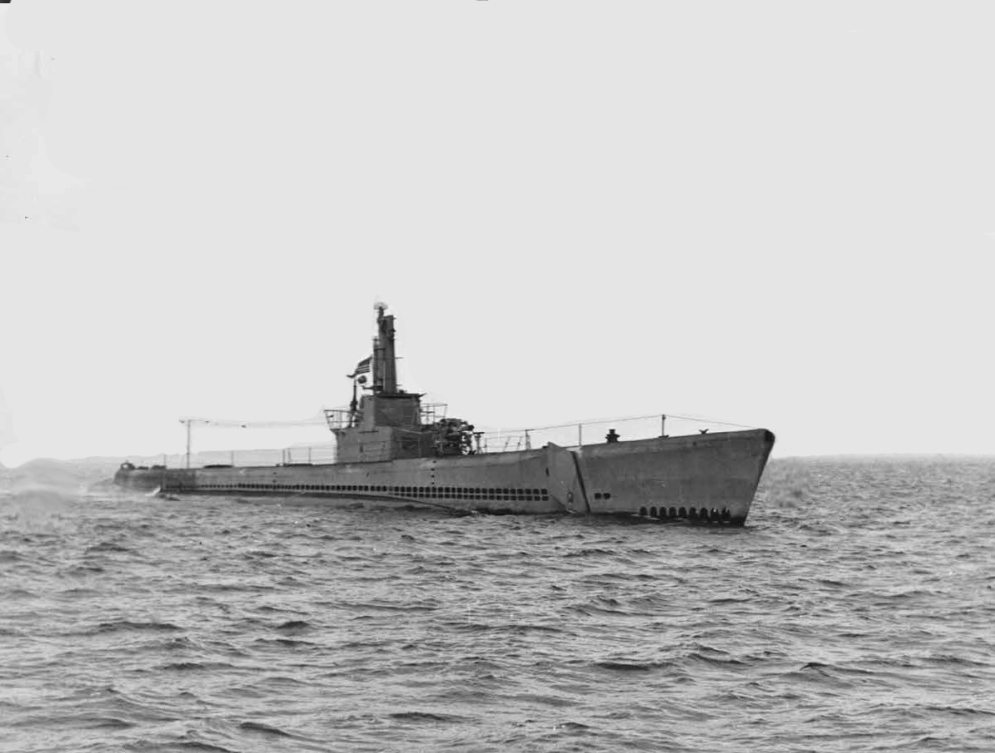According to the U.S. Department of Veterans Affairs, of the 16 million who served in the armed services in World War II, only about 325,000 American veterans were estimated to still be alive as of May, 2021. They became known as The Greatest Generation, a term popularized by the title of a 1998 book by American journalist Tom Brokaw. In the book, Brokaw profiled American members of this generation who came of age during the Great Depression and went on to fight in World War II. They included people on the home front; wives, sisters, sons and daughters, farmers, and many others who worked tirelessly to support the war effort.

In 1998, Tidings Magazine published a story entitled Four Vets on the Hill about four veterans of World War II, neighbors, who lived on a hill in Misquamicut, Rhode Island. Sadly, on May 22, 2021, the last of those veterans, Gordon Napier, passed away at the age of 96. During World War II Gordon had served on the USS Devilfish (SS-292), which has the distinction of being the only US submarine ever attacked and damaged by a Kamikaze. I thought it was a fascinating story and wanted to find out Gordon’s version of events.
When I interviewed Gordon in 2019 he told me, “I grew up in Hoboken, New Jersey and joined the Navy when I was 16 or 17 years old. My love of the water comes from my childhood watching the ships on the Hudson River. Steven’s Institute has a castle sitting on a pinnacle overlooking the Hudson River and from there you can see the George Washington Bridge up the river and the Statue of Liberty down river. I would spend all my time up at that point. I was seeing all these big steamships going to Europe and all over the world and so at a very early age, I identified with the water. I was drafted in Hoboken and went down to the draft board with my mother. They were putting most of the people in the army. I didn’t want to go in the army so I volunteered for the navy.”
“I got into the Navy and went to Newport to boot camp and then to diesel school at the Navy Pier in Chicago. It was winter and toward the end of school, I found myself in the hospital. The Navy Pier was a one mile long pier out into Lake Michigan and it was one hell of a cold place, let me tell you. We all got what they call Catarrhal Fever. When I finished the diesel course they were looking for volunteers for the submarine service and I wanted to do that and signed up.”
After Michigan, Gordon was sent to New London for 16 weeks of training in submarine operations and another eight week course in diesel engines. From there he went to new construction on the USS Devilfish in Philadelphia. Napier spent three years in the Pacific on board the Devilfish and was promoted to machinist mate first class. The Devilfish made four war patrols and has the distinction of being the only submarine ever attacked by a Kamikaze plane.
The USS Devilfish was a Balao Class Submarine, 312 in length, 27 foot beam, with a draft of 17 feet. There were 120 of these diesel-electric subs built and they were an improvement over the older Gato Class subs. They displaced 1,800 tons (surfaced and 2,400 tons (submerged). Top speed surfaced was 20 knots and submerged almost nine. Their range was 20,000 miles and armament consisted of one, up to five inch, deck gun, a number of anti-aircraft weapons, and six mounting points for 30 and 50 caliber machine guns. They had six bow and four stern torpedo tubes and their crews consisted of ten officers and 70 enlisted men. Devilfish was sunk by the submarine USS Wahoo off San Francisco, California on 14 August 1968, as part of a MK 16 MOD 8 torpedo test at 37°5′N 124°8′W in 2000 fathoms of water.
The Kamikaze attack happened while the Devilfish was commanded by Lieutenant Commander S. S. Mann, Jr. The sub was en route to her patrol area somewhere west of Iwo Jima on the afternoon of March 20, 1945. She was running on the surface and there had been nothing to break the routine until at 1645 the officer of the deck spotted a plane about five miles astern diving out of the clouds.
Napier explains, “When we got hit by the plane I was in the crew’s quarters which is the compartment just forward of the forward engine room. I’d just come off watch and I was going to get something to eat. The officer on the bridge after spotting the plane sounded the diving alarm and the Devilfish pulled the plug and dove. She was descending through 50 feet when we were hit. There was a noise like a light bomb exploding and the water started pouring in. The crew struggled to stop the influx of water that rushed into the conning tower and through the hatch into the control room. Electrical circuits were pulled in both places to prevent a fire. Eventually, the water was diverted into one of the periscope wells from where it could be pumped overboard.”
Even though the immediate danger of sinking was averted, the Devilfish had suffered considerable damage. The two periscopes were inoperable as were the radar and radio antennas, rendering the sub completely blind. Worried about his crippled boat and more attacks Commander Mann stayed submerged until nightfall.

“After night had fallen the Captain ordered the sub to surface to inspect the damage. We found that both the SD and SJ radar masts were damaged. There was an eight inch hole in the after periscope shears and two radio antennas and an underwater loop were destroyed.” As Mann and his crew examined the damage a piece of jagged aluminum wreckage was found stuck to the after periscope. Someone picked up a nameplate with Japanese characters inscribed on it. More debris was found on the sub’s deck, it looked like part of the landing gear of a plane. Then it hit them, it was a plane that crashed into the conning tower of the Devilfish. They didn’t know it at the time but later it was determined that the plane that struck them had been a Kamikaze.
Kamikazes were part of Japanese Special Attack Units that initiated suicide attacks against Allied naval vessels in the closing stages of the war. The name Kamikaze meant “the divine wind.” The name had been given to a typhoon wind that providentially destroyed an invading Mongol fleet in 1281. Kamikazes were loaded with high explosives and then purposely flown into ships blowing themselves and the ship up in the process. About 3,800 kamikaze pilots died during the war and more than 7,000 naval personnel were killed by kamikaze attacks. The Devilfish had been very lucky to survive.
Today, 75 years after that attack, Napier recalls that day, “I heard a lot of commotion and knew we had crash-dived. Afterward, the only people who could go topside were the lookouts and the officer of the deck. The captain didn’t want anybody to see how much damage had been done. That’s my evaluation. We had lost all of our radar, all of our radio antennas, and we couldn’t see through the periscope. We were blind but only partially deaf because our sonars still worked. We waited until dark to come up and then headed to Saipan.”
Later, based on the evidence, the Devilfish was credited with destroying an enemy plane and members of the crew were awarded the Submarine Combat Insignia. Gordon told me he had been heading to the galley when the plane hit. “That cook made the best cinnamon buns. I still can’t get enough of them till this day.”
When the war was over Gordon returned to the States onboard the Devilfish and was discharged. Because there were three million American service men and women who’d served overseas who had to be brought back to the states it was a difficult transition period. Gordon told me, “When I got to the States, I came back to Hoboken thinking I’m a first-class honcho now. I’m going to get a good job.” The problem was Gordon had not been given a high school diploma for his service. After two years of working low end jobs, he finally got a break. “My aunt, of all people, learned of a college out in Kansas that would take me, Southwestern College, in Winnfield, Kansas, way out in the boonies, with no water around. God, it was awful, from this sailor’s point of view, but the people there were great. I spent a year there and then transferred to URI.”
Gordon was in his junior year at URI when he met his wife Jean. “We got married and lived in a Quonset hut at the college. I graduated from URI with a major in English and a minor in history.” After that Gordon went to work at Electric Boat in Groton, Connecticut in an engineering job. He was happy to be working on submarines again. After 20 years he went to work at the Bath Iron Works in Maine estimating costs for new ship builds.
Jean and Gordon came back to Rhode Island and built a house in 1960 up on the hill. He worked at URI for almost 20 years doing institutional research before retiring. In his spare time, Gordon built quite a few small boats, the last a 26 foot Bartender. This is when I met him in about 1990. Jean and Gordon had two children, a son David, and a daughter Linda. Linda contracted MS and tragically passed away in 2014 after a valiant struggle with the disease.
Many years have passed since the end of World War II and most of the men and women who served are gone. Jean passed away in April of this year and in a familiar pattern of old couples, Gordon soon followed in May. My wife and I count ourselves lucky to have had these wonderful people as our friends.
I couldn’t end this story any better than what was written in Tidings years ago, “These veterans are enlightened by life, seasoned with wisdom and softened by years. They are the same men and women who in their prime gave their time and talents facing uncertainty, and the unspeakable horrors of war. Propelled by patriotism, duty and camaraderie, they mustered strength and bravery for the sake of our country. The Hill, and indeed the world, is a better place because of them. It may never again see a generation like it.”
